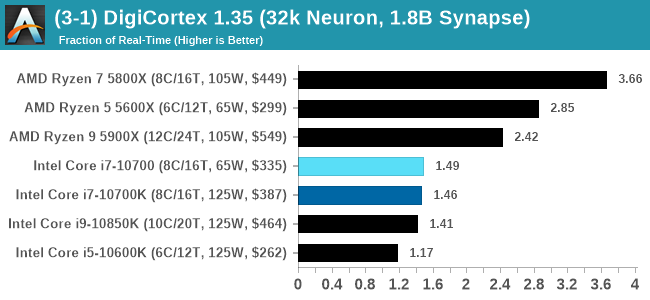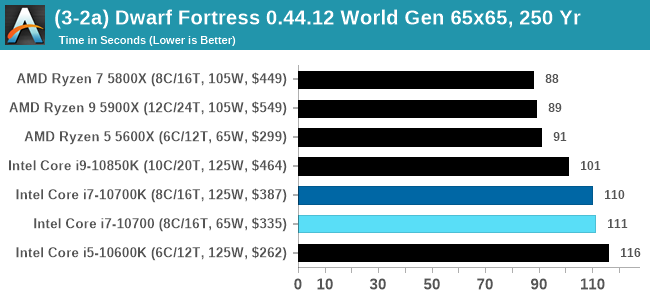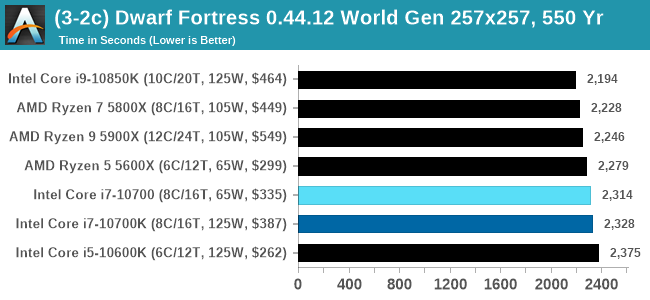Intel Core i7-10700 vs Core i7-10700K Review: Is 65W Comet Lake an Option?
by Dr. Ian Cutress on January 21, 2021 10:30 AM EST- Posted in
- CPUs
- Intel
- Core i7
- Z490
- 10th Gen Core
- Comet Lake
- i7-10700K
- i7-10700
CPU Tests: Simulation
Simulation and Science have a lot of overlap in the benchmarking world, however for this distinction we’re separating into two segments mostly based on the utility of the resulting data. The benchmarks that fall under Science have a distinct use for the data they output – in our Simulation section, these act more like synthetics but at some level are still trying to simulate a given environment.
DigiCortex v1.35: link
DigiCortex is a pet project for the visualization of neuron and synapse activity in the brain. The software comes with a variety of benchmark modes, and we take the small benchmark which runs a 32k neuron/1.8B synapse simulation, similar to a small slug.
The results on the output are given as a fraction of whether the system can simulate in real-time, so anything above a value of one is suitable for real-time work. The benchmark offers a 'no firing synapse' mode, which in essence detects DRAM and bus speed, however we take the firing mode which adds CPU work with every firing.
The software originally shipped with a benchmark that recorded the first few cycles and output a result. So while fast multi-threaded processors this made the benchmark last less than a few seconds, slow dual-core processors could be running for almost an hour. There is also the issue of DigiCortex starting with a base neuron/synapse map in ‘off mode’, giving a high result in the first few cycles as none of the nodes are currently active. We found that the performance settles down into a steady state after a while (when the model is actively in use), so we asked the author to allow for a ‘warm-up’ phase and for the benchmark to be the average over a second sample time.
For our test, we give the benchmark 20000 cycles to warm up and then take the data over the next 10000 cycles seconds for the test – on a modern processor this takes 30 seconds and 150 seconds respectively. This is then repeated a minimum of 10 times, with the first three results rejected. Results are shown as a multiple of real-time calculation.

For users wondering why the 5800X wins, it seems that Digicortex prefers single chiplet designs, and the more cores the better. On the Intel side, the 10700 pulls a slight lead.
Dwarf Fortress 0.44.12: Link
Another long standing request for our benchmark suite has been Dwarf Fortress, a popular management/roguelike indie video game, first launched in 2006 and still being regularly updated today, aiming for a Steam launch sometime in the future.
Emulating the ASCII interfaces of old, this title is a rather complex beast, which can generate environments subject to millennia of rule, famous faces, peasants, and key historical figures and events. The further you get into the game, depending on the size of the world, the slower it becomes as it has to simulate more famous people, more world events, and the natural way that humanoid creatures take over an environment. Like some kind of virus.
For our test we’re using DFMark. DFMark is a benchmark built by vorsgren on the Bay12Forums that gives two different modes built on DFHack: world generation and embark. These tests can be configured, but range anywhere from 3 minutes to several hours. After analyzing the test, we ended up going for three different world generation sizes:
- Small, a 65x65 world with 250 years, 10 civilizations and 4 megabeasts
- Medium, a 127x127 world with 550 years, 10 civilizations and 4 megabeasts
- Large, a 257x257 world with 550 years, 40 civilizations and 10 megabeasts
DFMark outputs the time to run any given test, so this is what we use for the output. We loop the small test for as many times possible in 10 minutes, the medium test for as many times in 30 minutes, and the large test for as many times in an hour.



Dolphin v5.0 Emulation: Link
Many emulators are often bound by single thread CPU performance, and general reports tended to suggest that Haswell provided a significant boost to emulator performance. This benchmark runs a Wii program that ray traces a complex 3D scene inside the Dolphin Wii emulator. Performance on this benchmark is a good proxy of the speed of Dolphin CPU emulation, which is an intensive single core task using most aspects of a CPU. Results are given in seconds, where the Wii itself scores 1051 seconds.













210 Comments
View All Comments
Oxford Guy - Monday, January 25, 2021 - link
'What if I don't agree about the location of the "sweet spot" based on RAM prices local to me, or my own performance needs?'Price vs. performance is a different topic. Nice attempt to change the subject, though.
Spunjji - Wednesday, January 27, 2021 - link
It's not at all an attempt to change the subject. The point is that the issue of an "optimal" RAM speed is a moving target dependent on multiple variables.Makste - Saturday, January 23, 2021 - link
As a part of his audience, I am actually satisfied with this review, as I am looking for the out of the box experience. I'm most likely not to tamper with the manufacturer's recommendations. So he tested the CPUs following both Intel and AMD recommendations. Something I don't see a problem with.Oxford Guy - Sunday, January 24, 2021 - link
Turning on XMP is hardly tampering, particularly since motherboard vendors provide lists of recommended RAM to use those XMP profiles with.theqnology - Monday, January 25, 2021 - link
If it shouldn't be the case, shouldn't consumers take it up with Intel, and not with the reviewer? Why does Intel put lower max than the current JEDEC standards (e.g., Intel at 2933 while AMD at 3200)? I ask, if Intel was so confident about their products, why not up the official support?This is really the crux of it. Intel wants to make it part of the difference between their Z boards and their non-Z boards, which adds more cost for the consumers, while at the same time washing themselves from this responsibility should something not work (you cannot RMA based on non-JEDEC compatibility). It is also fascinating that consumers think this is on the reviewers.
Oxford Guy - Monday, January 25, 2021 - link
Sure, as long as the reviewer is consistent with the logic.That means no reviewing boards that violate the official base clock and turbo behavior.
Things like that.
Spunjji - Wednesday, January 27, 2021 - link
Then he can't review any board at all.Honestly, this "everything must be treated exactly the same otherwise nothing is fair" rhetoric is ghastly and corrosive in whatever domain it's applied.
Qasar - Thursday, January 28, 2021 - link
" That means no reviewing boards that violate the official base clock and turbo behavior. "considering that intel doesnt make board makers conform to anything as far as what " default " would be, good luck with this.
quiq - Sunday, January 24, 2021 - link
i want to view the 1070 whit stock box and a h410/470 motherboard thats the real user for a non k cpuvs 10700k and z490 aftermarket HeatSink or WC Oc memories etc Real entusiast cpu
IanCutress - Saturday, January 23, 2021 - link
Please go ahead and enforce both Intel and AMD to rate their memory controllers faster then. Its not opinion, it's the literal standard,and the only way to ensure consistency for comparisons across generations. I'm not going to offer one CPU a higher dram overclock than another, that isn't fair, just in the same way I'm not going to overclocked the cores. I regularly dive into AT's audience metrics, and have done for years. If you want data that's different, then please by all means either do your own testing or find other reviews. But you know, also get them to deep dive into microarchitecture as well as get all the behind the curtain info. Also, all our content is free at the point of use. By your logic, I'm also a consumer of content at AT, thus I also pay my salary. Please enjoy.